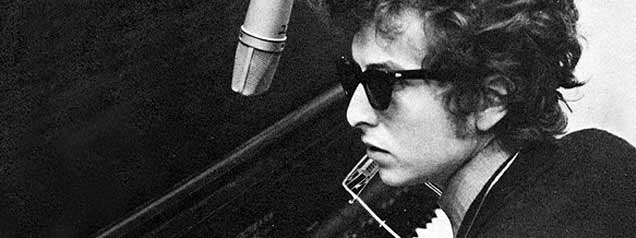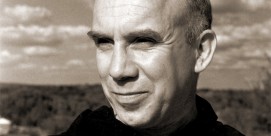Bob Dylan: American Adam
by David E. Anderson
“Folk songs are evasive — the truth about life, and life is more or less a lie, but then again that’s exactly the way we want it to be.” — Bob Dylan, Chronicles: Volume One
How many personas does Bob Dylan have?
How many pages are there in a book? Or days in a year? Or, perhaps most important, how many songs in a story?
“A folk song,” Dylan wrote in the first volume of his memoirs, “Chronicles,” “has over a thousand faces, and you must meet them all if you want to play this stuff.”
Over the course of his long career, Bob Dylan has become one of the world’s most important cultural figures. By the sheer magnitude of his talent and duration of his survival, Dylan is now an entertainment icon and elder statesman whose Delphic riddling rhymes and gnomic puns are no longer part of the countercultural margins but are sought out by such paragons of mainstream culture as 60 Minutes and Newsweek magazine.

His influence has extended well beyond the United States and well beyond his chosen genre of songwriting to literature, film, politics, and religion. His work and his many personae are, at turns, not only insightful and inspirational, wise, difficult, and mysterious but also contradictory, inconsistent and, yes, self-serving.
As he approaches his 70th birthday on May 24, one is tempted to speculate that he is also tamed, enjoying a new kind of fame — that of the establishment. Yet such acceptance — an honorary degree from Princeton, a set of Grammys, a Kennedy Center award, among many other accolades after a decade and a half of being dismissed as passé and something of a has-been — has made Dylan no easier to understand, no easier to parse, and no less compelling a writer, one who both shapes and is shaped by the best and worst of America.
You can pick your badge of honor or outrage. He sang in Mississippi during the civil rights movement, denounced the war in Vietnam, embraced a strident and judgmental Protestant fundamentalism, lauded the poetry of the gay Beat and Buddhist poet Allen Ginsberg, condemned corporate greed, remained silent on Central America, celebrated Zionist nationalism, failed to credit members of the band on one of his major albums, and appeared in a Victoria’s Secret lingerie commercial.
As attention again focuses on him, the critical debates also rage about who he is, what his work means, and what of his vast oeuvre matters.
He is hailed, but not unanimously, as a superb songwriter and musician and lauded as one of the best poets of the second half of the 20th century. He is the subject of hundreds of academic articles, numerous college courses, and dozens of books, including literary critic Christopher Ricks’s “Dylan’s Vision of Sin” and New Testament scholar Michael J. Gilmour’s “Tangled Up in the Bible: Bob Dylan and Scripture.”. A more complete edition of his song lyrics has been published, providing both fans and scholars ready access to the songs as written (but not necessarily as performed).
Over the years, Dylan has refused to be confined to the boxes into which his fans — and sometimes critics — seek to put him, whether political, religious, or even musical. He seems almost a caricature of the American Adam, constantly reinventing his public and musical self, always ready, like Huck Finn, “to light out for the Territory ahead of the rest” when Aunt Sally and “sivilization” (his fans and critics) threaten to hem him in. We all should have learned by now that “he not busy being born is busy dying.”
Still, as a 21st-century version of Walt Whitman, the poet he perhaps most emulates, he has consistencies and repeated themes in his many selves and their reinventions, whether amid the radicalism of the 1960s or the religiosity of the 1980s. From his first recordings, when he was still apprenticing himself to the folk and blues traditions, religious concerns and moral motifs have permeated the work as they do those musical traditions. Religious and biblical language has been a consistent but always complex and sometimes contradictory element. As he said in a 1963 interview, “There’s mystery, magic, truth, and the Bible in great folk music. I can’t hope to touch that. But I’m going to try.”
Such language seems to run through his work in the way theologians once talked about some “red thread” versions of the Bible used to denote the words of Jesus. Religious and biblical language has been part of the many public versions of Dylan, whether political, religious, countercultural, or minstrel. He may well be among the last generation for whom biblical language is a normal part of literary allusion and discourse and not an affectation or a necessary signal of a dogmatic belief system.
Thus it is important to note that at root, as English critic Michael Gray has pointed out, Dylan is a moralist rather than the prophet many of his fans, both secular and religious, have longed for. His songs are about the struggle for a moral code, and it is, ultimately, the music that provides his religious framework. As Gray puts it in his important study of Dylan, “Song and Dance Man III,” “Along with this unfailing sense of the need for moral clarity, Dylan’s work has also been consistently characterized by a yearning for salvation. In fact the quest for salvation might well be called the central theme of Bob Dylan’s entire output. To survive, you must attain that clarity of morality: you won’t even get by without going that far, and then you must go beyond — get rescued from the chaos and purgatory and find some spiritual home.”
Dylan’s use of religious motifs and biblical imagery has sparked a host of commentaries and critical analyses, many by evangelical Christians. As fans and critics in the 1960s sought to make Dylan a spokesman for a generation involved in the civil rights and antiwar movements (a role he ultimately rejected, as he writes movingly but not always convincingly in “Chronicles”), so too many evangelicals welcomed his celebrated conversion to fundamentalist Christianity and sought to define the minstrel as minister. For a brief period after his 1978 conversion, Dylan appeared willing to play that role, sometimes preaching from the stage, just as he had, for an equally brief time, embraced the persona of himself as the reincarnation of Woody Guthrie, social critic.
For some evangelical Christian critics who were drawn to the music but not to the civil rights and peace politics of the 1960s and who dismissed Dylan’s “contemptuous insult-songs,” such as “Masters of War” and “With God on Our Side,” the conversion to fundamentalist Protestantism was a vindication of their politics, an affirmation of their religion and their notion of the “prophetic.” The simplistic contempt for the “unsaved” in Dylan’s “born-again” songs (“Ain’t No Man Righteous, No Not One” and “Gotta Serve Somebody”) didn’t seem to bother them at all, and some even admitted to smirking at the discomfort of Dylan’s non-evangelical fans who were either puzzled or turned off by the thoroughgoing religious songs.
But the fundamentalist phase didn’t last long, either. Dylan was soon back to playing his old songs, even if he kept his public distance from their politics, and writing new material that was less strident in its religious expression. Yet it should be noted that he has not renounced or recanted the songs of his fundamentalist period any more than the songs of his political protest period. The best of both continue to be part of his repertoire.
While certainty of conviction can be a virtue in religious belief systems, it can work against creativity, which requires the artist to go beyond the last poem, the last canvas, to a new configuration. For a songwriter and performer like Dylan, there is always a new story to tell, a new way of telling the old story, and unlike dogmatic formulas, such new tellings change the meanings of the old versions.

In a famous interview with David Gates of Newsweek, Dylan put it this way: “I don’t know who I am most of the time. It doesn’t even matter to me. … I find the religiosity and the philosophy in the music. I don’t find it anywhere else. … I believe the songs.”
Ultimately, that is what “Chronicles” is — a kind of musical memoir rather than an autobiography. It is the past remembered and refracted through time and the imagination, not a literal reconstruction. There is very little of politics or religion or any of the other controversies that have marked Dylan’s career. For all the sense of intimacy, there is little for those seeking clues to Dylan’s “real” life — the private life — beyond the songs. Those wanting details of the 1966 motorcycle accident or the role of drugs or the Bible study at the Vineyard church won’t find much in the book. Perhaps in the promised volumes two and three.
What they will find is a warm and generous and at times exuberant reflection by Dylan on points of his pilgrimage — the first days in Greenwich Village; the making of the 1989 “Oh Mercy” album at perhaps one of the lowest points in his career after the born-again phase; his incubator time in Minneapolis, where he was exposed to many of the folk traditions that were growing in popularity.
“Chronicles” is also instructive for critics and theologians like Ricks and Gilmour, whose interpretations of Dylan’s work, while often fascinating, informative, and suggestive, are sometimes overdetermined. Dylan writes, for example, of trying to “fix” the last line of “Ring Them Bells” — “breaking down the distance between right and wrong.” Ricks stresses Dylan’s use of the word “distance” rather than “difference” between right and wrong. “This makes all the difference in the world and in the other world,” he writes.
But Dylan writes that “while the line fit, it didn’t verify what I felt. Right or wrong, like it fits in the Wanda Jackson song, or right from wrong, like the Billy Tate song, that makes sense, but not right and wrong. The concept didn’t exist in my subconscious mind. I’d always been confused about that kind of stuff, didn’t see any moral ideal played out there. The concept of being morally right or morally wrong seems to be wired to the wrong frequency.”
Reading “Chronicles” is a little bit like listening to a Dylan album. There are always stunning moments, puzzling moments, and some clinkers. The book is studded with wonderful lines that defy easy explication. Of Roy Orbison he writes: “He sang like a professional criminal.” You know it’s a compliment, but what exactly does it mean?
Among the off notes is a chapter called “The Lost Land,” which reads a little like every celebrity’s put-down of the price of fame even as they pursue it. It is cliche-ridden (“Truth was that I wanted to get out of the rat race”) and unconvincing (“I was more a cowpuncher than a Pied Piper” and “what I was fantasizing about was a nine-to-five existence, a house on a tree-lined block with a white picket fence, pink roses in the backyard”). Sure, Bob. Yet there is nothing here of family, nothing of the meaning and significance of fatherhood, only the textureless assertion of the fantasy.
What shines in “Chronicles,” however, is Dylan’s warm and generous assessment of other musicians, those he learned from, those he admired, and even, like Joan Baez, those with whom he has broken. Many fans will be surprised at the wide range of his musical tastes and interests. There are, of course, the obvious folk, blues, and gospel performers such as Woody Guthrie, Robert Johnson, and Odetta, along with his own contemporaries, especially Dave Von Ronk, Ramblin’ Jack Elliott, and Mike Seeger. But he also expresses regard for many of the performers dismissed by folk “purists” of the 1960s, such as the Kingston Trio, and voices appreciation for the music of jazz musicians Thelonius Monk, Miles Davis, and Duke Ellington, as well as pop and early rock singers such as Ricky Nelson.
Which is to say that “Chronicles,” like the person — and for good or ill — is mostly about the music and his own highs and lows in relationship to it.
“A song is like a dream,” writes Dylan, and it seems true of his long career as well, “and you try and make it come true.”
David E. Anderson is senior editor for Religion News Service.







